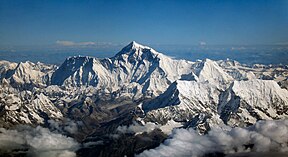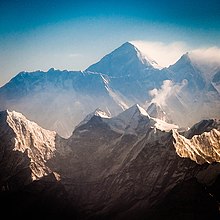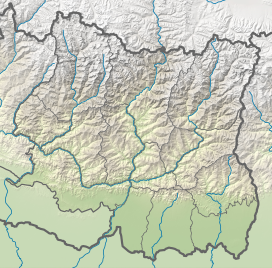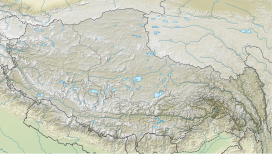
Back Gunong Everest ACE Everest Afrikaans Mount Everest ALS ኤቨረስት ተራራ Amharic Everest AN Eferest Beorg ANG एवरेस्ट ANP جبل إفرست Arabic جبل إيڤريسط ARY ايفيريست ARZ
| Mount Everest | |
|---|---|
 | |
| Highest point | |
| Elevation | 8,848.86 m (29,031.7 ft) Ranked 1st |
| Prominence | Ranked 1st (Special definition for Everest) |
| Isolation | n/a |
| Listing | |
| Coordinates | 27°59′18″N 86°55′31″E / 27.98833°N 86.92528°E[1] |
| Naming | |
| Etymology | George Everest |
| Native name |
|
| English translation | Holy Mother, Skyhead |
| Geography | |
Location on the border between Koshi Province, Nepal and Tibet Autonomous Region, China | |
| Location | Solukhumbu District, Koshi Province, Nepal;[2] Tingri County, Xigazê, Tibet Autonomous Region, China[note 2] |
| Countries | China and Nepal |
| Parent range | Mahalangur Himal, Himalayas |
| Climbing | |
| First ascent | 29 May 1953 Edmund Hillary and Tenzing Norgay [note 3] Ranked 1st |
| Normal route | Southeast ridge (Nepal) |


Mount Everest[3] is Earth's highest mountain above sea level, located in the Mahalangur Himal sub-range of the Himalayas. The China–Nepal border runs across its summit point.[4] Its elevation (snow height) of 8,848.86 m (29,031 ft 8+1⁄2 in) was most recently established in 2020 by the Chinese and Nepali authorities.[5][6]
Mount Everest attracts many climbers, including highly experienced mountaineers. There are two main climbing routes, one approaching the summit from the southeast in Nepal (known as the "standard route") and the other from the north in Tibet. While not posing substantial technical climbing challenges on the standard route, Everest presents dangers such as altitude sickness, weather, and wind, as well as hazards from avalanches and the Khumbu Icefall. As of November 2022, 310 people have died on Everest. Over 200 bodies remain on the mountain and have not been removed due to the dangerous conditions.[7][8]
The first recorded efforts to reach Everest's summit were made by British mountaineers. As Nepal did not allow foreigners to enter the country at the time, the British made several attempts on the north ridge route from the Tibetan side. After the first reconnaissance expedition by the British in 1921 reached 7,000 m (22,970 ft) on the North Col, the 1922 expedition pushed the north ridge route up to 8,320 m (27,300 ft), marking the first time a human had climbed above 8,000 m (26,247 ft). The 1924 expedition resulted in one of the greatest mysteries on Everest to this day: George Mallory and Andrew Irvine made a final summit attempt on 8 June but never returned, sparking debate as to whether they were the first to reach the top. Tenzing Norgay and Edmund Hillary made the first documented ascent of Everest in 1953, using the southeast ridge route. Norgay had reached 8,595 m (28,199 ft) the previous year as a member of the 1952 Swiss expedition. The Chinese mountaineering team of Wang Fuzhou, Gonpo, and Qu Yinhua made the first reported ascent of the peak from the north ridge on 25 May 1960.[9]
Cite error: There are <ref group=note> tags on this page, but the references will not show without a {{reflist|group=note}} template (see the help page).
- ^ "Mount Everest". Peakbagger.com.
- ^ Geography of Nepal: Physical, Economic, Cultural and Regional by Netra Bahadur Thapa, D. P. Thapa Orient Longmans, 1969.
- ^ (Nepali: सगरमाथा, romanized: Sagarmāthā; Standard Tibetan: ཇོ་མོ་གླང་མ, romanized: Chomolungma; Chinese: 珠穆朗玛峰; pinyin: Zhūmùlǎngmǎ Fēng)
- ^ Bishart, Andrew (4 May 2016). "China's New Road May Clear a Path for More Everest Climbers". National Geographic. Archived from the original on 21 September 2018.
- ^ "Mount Everest is two feet taller, China and Nepal announce". National Geographic. Archived from the original on 8 December 2020. Retrieved 8 December 2020.
- ^ Joe Phelan (28 October 2022). "Is Mount Everest really the tallest mountain on Earth? It depends how you measure height". livescience.com. Future US, Inc. Retrieved 27 April 2023.
Researchers have measured Mount Everest many times over the past few decades, but the latest assessment, announced in November 2021, puts it at 29,031.69 feet (8,848.86 meters), which is almost 5.5 miles (8.8 kilometers) tall.
- ^ "How Many Dead Bodies Are On Mount Everest?". climbernews.com. Climber News. 7 November 2022. Retrieved 27 April 2023.
As of November 2022, 310 people have died while attempting to climb Mount Everest.
- ^ Rachel Nuwer (8 October 2015). "Death in the clouds: The problem with Everest's 200+ bodies". BBC. Retrieved 27 April 2023.
- ^ Lewis, Jon E. (2012). "Appendix 1". The Mammoth Book of How it Happened – Everest. Little, Brown Book Group. p. 212. ISBN 978-1-78033-727-2.
© MMXXIII Rich X Search. We shall prevail. All rights reserved. Rich X Search




